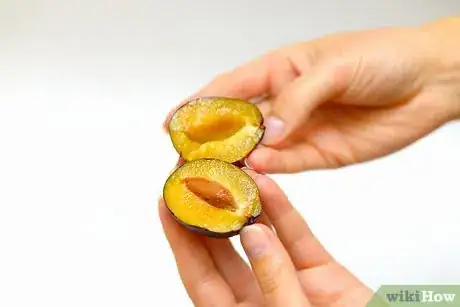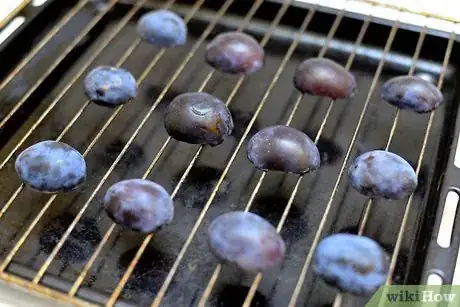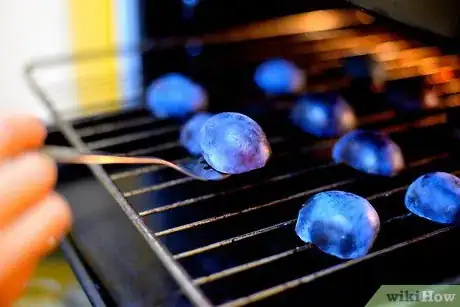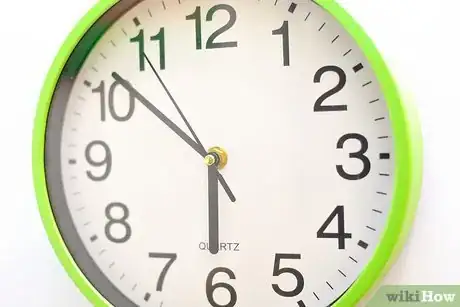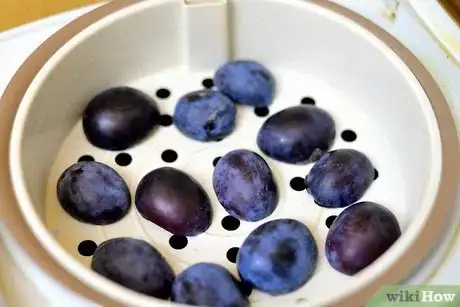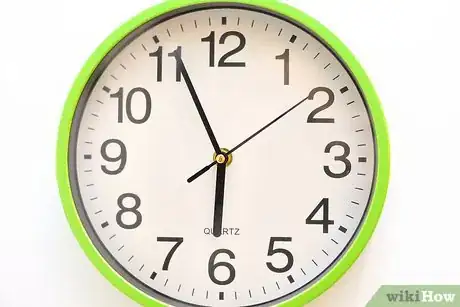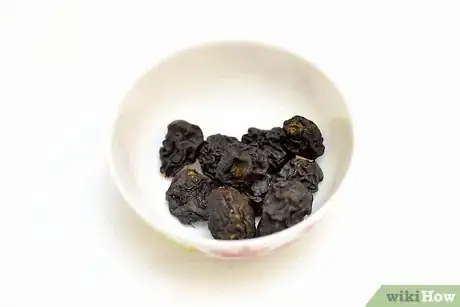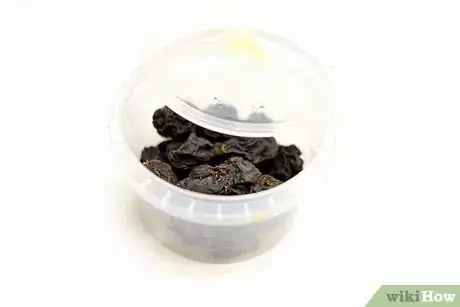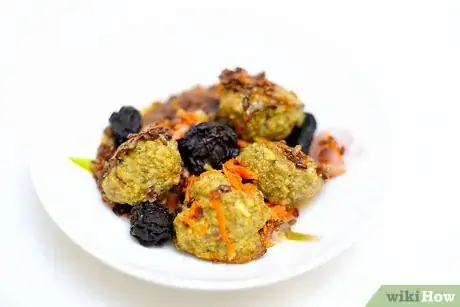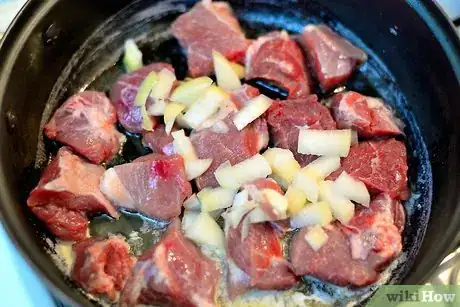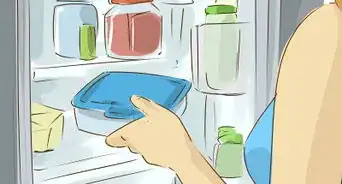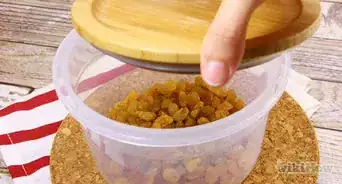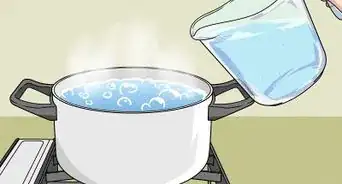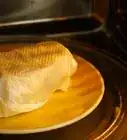This article was co-authored by wikiHow Staff. Our trained team of editors and researchers validate articles for accuracy and comprehensiveness. wikiHow's Content Management Team carefully monitors the work from our editorial staff to ensure that each article is backed by trusted research and meets our high quality standards.
There are 8 references cited in this article, which can be found at the bottom of the page.
wikiHow marks an article as reader-approved once it receives enough positive feedback. In this case, 100% of readers who voted found the article helpful, earning it our reader-approved status.
This article has been viewed 135,554 times.
Learn more...
Prunes can be a healthy, nutritious snack to add to any meal. However, making prunes at home can take some time. You can either use a dehydrator or oven to make prunes. From there, store the prunes properly. When you want to use prunes, you can use them in a variety of dishes to add additional flavor.
Steps
Using an Oven
-
1Cut your plums and remove the pits. Slice the plums in half around the pit, working with a small, sharp knife. Pull the halves apart, remove the pit, and discard the pit.[1]
- Make sure you work with a knife small enough to handle. A large knife is not appropriate for cutting plums.
-
2Place the plums directly on the oven rack. Do not use a baking pan to make prunes in the oven. A lot of juices will leak from the plums during the drying process. If plums are on a baking pan, they will stick to this surface. Instead, use an oven rack. Make sure to space the plums evenly on the oven rack. If the plums are touching, this may affect the dehydration process.[2]
- As the process can make a mess on the bottom of your oven, consider setting something down to catch the drippings. Some people find success laying a single sheet of foil on the bottom of the oven. However, the foil may melt and it does not work for gas ovens.[3] You could try lining a baking tray with foil and setting that under the plums.
Advertisement -
3Set the plums in the oven at 200 degrees Fahrenheit. You should set the oven as low as possible. For most ovens, that is 200 degrees Fahrenheit. If your oven is different, simply set the oven to the lowest possible temperature.[4]
- Make sure to place the oven rack in the oven slowly. You do not want to knock the plums around.[5]
-
4Check the plums every few hours. You should flip the plums every few hours so they dry out evenly. You should also check on how the dehydration process is coming along. You want your prunes to be slightly soft and juicy, while also being dry to the point of having a wrinkled, dark appearance.[6]
- This also depends on personal preference. Some people prefer prunes slightly dryer while some prefer them juicier. Do not remove the prunes until they're at your desired state.
-
5Heat your prunes for around 8 hours. While most prunes will be ready at this point, vigilant checking is important. Some prunes will be ready sooner than 8 hours, and some will need a little more time.[7]
- The prunes will probably be ready at slightly different rates. Remove them as needed.
Using a Dehydrator
-
1Cut your plums and remove the pits. Remove the stem. Then, cut the plum in half around the pit using a sharp pairing knife.[8] [9]
- Pull the two halves of the plums apart. Remove the pit and discard.
- If you don't have a pairing knife, you can use another sharp knife. However, be sure to avoid a large knife. Plums are small, and you want to make sure you maintain control of your knife as you cut around the pit.
-
2
-
3Place the tray in the dehydrator. You should dehydrate your foods at 115 °F (46.1 °C) when working with a conventional dehydrator. However, if you have an excalibur dehydrator, start out at 145 degrees.[12] [13]
- Make sure the dehydrator is at the right temperature before placing the plums in the oven.
- Place the tray in the dehydrator slowly to avoid knocking the plums together.
-
4Check the plums every 4 to 6 hours. You want to turn the plums at some point to complete the dehydration process. Check every 4 to 6 hours to see if the plums are ready to turn.[14]
- When plums are ready to turn, the upside should be very dry. The plums should release easily from the tray.
- If the upside of the plum is still moist, and the plum does not come off easily, leave the plums for a bit longer before turning them.
-
5Check every 2 hours when you begin removing prunes. The plums will turn into prunes at different rates. When you notice some plums completely lack moisture, they've completed the pruning process. These should be removed from the dehydrator. After this, start checking on the plums ever 2 hours, as they're getting close to being done.[15]
-
6Allow the plums to dehydrate for 14 hours. Plums will take roughly 14 hours to fully dehydrate. However, they may take longer or shorter depending on the quality of the plums. This is why it's important to check your plums regularly during the dehydrating process. When fully dehydrated, you will have black, wrinkled, raisin-like prunes.[16]
Storing and Eating Your Prunes
-
1Store your prunes properly. Dried prunes should be placed in an airtight container. A heavy duty plastic bag is also appropriate.[17]
- You can store prunes in a cool, dark area.
- Prunes can be safely stored in the pantry, the refrigerator, or the freezer.
-
2Discard prunes after they spoil. The shelf life of prunes depends on where you store them. Make sure to know the shelf life of your prunes to avoid eating spoiled fruit.[18]
- In the pantry and fridge, dried prunes will last 6 to 12 months.
- The freezer can extend the shelf life of a dried prune. Dried prunes stored in the freezer can last 12 to 18 months.
-
3Add prunes to a stuffing. If it's around Thanksgiving, dried prunes can make a tasty addition to any stuffing. When sautéing other items for the stuffing, like onion and celery, toss in the prunes as well. Cook everything together for a few minutes, and then remove the mixture from the heat.[19]
- Prunes can add a slightly sweet flavor to a stuffing, which can shake up a stuffing made with mostly savory ingredients.
-
4Serve stuffed prunes as an appetizer. You can stuff prunes with Stilton or another type of cheese for a sweet and savory appetizer. You simply cut the prunes through the center and then fill them with cheese.
- Stuffed prunes would make a great snack for an elegant dinner party.
-
5Garnish a pot roast with prunes. Prunes can compliment beef nicely. Usually, you would add the prunes, in addition to any other garnishes, about halfway through the cooking process. However, refer to your specific recipe to make sure this is safe given the type of roast you're making.[20]
Community Q&A
-
QuestionWhen drying Italian plums, does one need to rub the natural powdery coating off first, or just rinse?
 CaeiiaTop AnswererYou can just rinse; it's not harmful.
CaeiiaTop AnswererYou can just rinse; it's not harmful. -
QuestionThose are all dried plums, not prunes. How do I make the prunes like I buy in the stores? Somewhat dried but still soft and chewy. I have dried plums, but cannot get that consistency.
 Community AnswerYou should try "sweating" them. This is how dried grapes become raisins. The grapes are gathered in boxes and packed tightly. The duration I'm not sure of, but I make my prunes "store like" by placing them in a gallon-sized plastic bag and remove most of the air by rolling and squeezing the bag, redoing it several times.
Community AnswerYou should try "sweating" them. This is how dried grapes become raisins. The grapes are gathered in boxes and packed tightly. The duration I'm not sure of, but I make my prunes "store like" by placing them in a gallon-sized plastic bag and remove most of the air by rolling and squeezing the bag, redoing it several times. -
QuestionCan I make a homemade dehydrator?
 Community AnswerYes. One way is to set up a pizza tray with a fly net on top and sit it in the heat when the temperature is above 30 degrees C or 80 F.
Community AnswerYes. One way is to set up a pizza tray with a fly net on top and sit it in the heat when the temperature is above 30 degrees C or 80 F.
References
- ↑ http://domesticdreamboat.com/dry-prunes-without-food-dehydrator/
- ↑ http://domesticdreamboat.com/dry-prunes-without-food-dehydrator/
- ↑ https://www.apartmenttherapy.com/do-or-dont-using-foil-as-an-oven-liner-201252
- ↑ https://www.thekitchn.com/how-to-dry-fruit-in-the-oven-92637
- ↑ http://domesticdreamboat.com/dry-prunes-without-food-dehydrator/
- ↑ http://domesticdreamboat.com/dry-prunes-without-food-dehydrator/
- ↑ http://domesticdreamboat.com/dry-prunes-without-food-dehydrator/
- ↑ https://www.youtube.com/watch?v=c-YOQkKUYzI
- ↑ http://anoregoncottage.com/how-to-dry-plums/
- ↑ http://anoregoncottage.com/how-to-dry-plums/
- ↑ https://www.youtube.com/watch?v=c-YOQkKUYzI
- ↑ http://anoregoncottage.com/how-to-dry-plums/
- ↑ https://www.youtube.com/watch?v=c-YOQkKUYzI
- ↑ http://anoregoncottage.com/how-to-dry-plums/
- ↑ http://anoregoncottage.com/how-to-dry-plums/
- ↑ https://www.youtube.com/watch?v=c-YOQkKUYzI
- ↑ http://www.stilltasty.com/fooditems/index/18840
- ↑ http://www.stilltasty.com/fooditems/index/18840
- ↑ http://www.bbc.co.uk/food/recipes/myfavouritestuffing_13964
- ↑ http://www.bbc.co.uk/food/recipes/pot-roasted_beef_with_34529
About This Article
To make prunes, start by cutting plums in half and removing the pits. Then, place the plums on an oven rack with a foil-lined tray underneath to catch the juices. Next, heat the prunes on the lowest temperature of your oven for 8 hours, but check them every few hours in case they're ready sooner. Once the skin on your prunes is dark and wrinkled, remove them from the oven and store them in a sealed container inside your pantry. For tips on how to make prunes using a dehydrator, read on!
